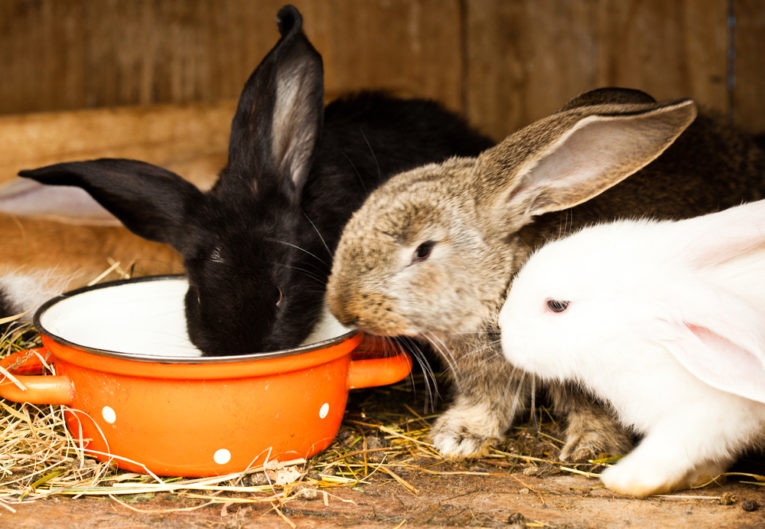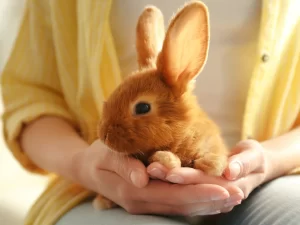As summer approaches, warmer temperatures and higher humidity can be very detrimental to the health of our furry friends, especially rabbits, who are more susceptible to heat stress. Rabbits don’t sweat; their ears keep their bodies at the right temperature. As temperatures rise, overheating, heat stroke, and other associated problems are likely to occur. You can use this complete guide to ensure your rabbit stays cool, hydrated, and healthy during the warm months.
1. Understanding Heat Stress in Rabbits:
When a rabbit’s body temperature becomes too high, this is called heat stress. This can lead to heat stroke. Some symptoms include shortness of breath, fatigue, drooling, and, in the worst cases, seizures or fainting. Immediate action is required to avoid fatal consequences.
2. Creating a Cool Environment:
- Keeping Indoors: Bring rabbits that live outside indoors when it is warm outside. Being indoors can help you control temperatures and keep your pet out of direct sunlight.
- Shade and Air Circulation: If your rabbit must stay outside, make sure his cage has good air circulation and shade. Do not place the cage in a sunny spot. Use a fan to move the air, but keep your rabbit out of drafts.
- Cooling Accessories: You can provide your rabbit with a cooling pad, marble tiles, or a frozen water bottle wrapped in a towel to create a cool place to stay.
3. Hydration and Diet:
- Access to Fresh Water: Make sure your rabbit has easy access to fresh, cool water. Check your water bottle or bowl and refill it several times a day. By putting ice cubes in the water, it stays cool longer.
- Water-Rich Foods: Give them fresh vegetables that are rich in water. Green leafy vegetables such as lettuce, onions, and peppers can help you stay hydrated.
4. Watch and Practice:
- Check Regularly: Monitor your rabbit for signs of heat stress, especially when it is warm outside. Early detection is important for quick action.
- Exercise Sensibly: don’t do too much physical activity when it’s hot. Playtime should take place when the weather is cooler, such as early in the morning or late in the evening.
5. Hair Care and Beauty:
- Groom Your Rabbit Regularly: Groom your rabbit regularly during the summer to remove excess fur, which will keep it cool. For long-haired breeds, consider cutting them short.
- How to Prevent Heat Stroke: Know the symptoms of heat stroke (wheezing, fatigue, and drooling) and act quickly. Take your rabbit to a cool place, wet his ears with cool (not cold) water, and call your vet immediately.
6. Provides Protection:
- Control Pests: Escape, tick, and fly pests appear more often in the summer. Fly strike is a dangerous condition that occurs when flies lay eggs on a rabbit, which then hatch into maggots. Clean your living space, use safe methods to remove pests, and check your rabbit regularly for signs of pests.
- Veterinary Care: Before summer starts, take your pet to the vet for a checkup to address any health concerns and discuss additional preventive care.
Conclusion:
Caring for rabbits in the summer requires hard work, advance planning and an understanding of rabbits’ special sensitivity to heat. You can help your rabbit stay safe this summer by providing him with a cool, comfortable living environment, making sure he gets enough food and water, and watching for signs of discomfort. Remember that protection is essential. To ensure that your rabbit has a happy and healthy summer, you need to take steps to protect him from the dangers of heat.
FAQs:
1. Can rabbits spend the summer outside?
In summer, it can be placed outdoors, but it should be placed in a cool, well-ventilated place, away from direct sunlight. If the cage is outside, it should be kept cool using objects such as frozen water bottles or tiles. But if it’s really hot outside, it’s safer to bring them inside.
2. What is the best way to cool down my rabbit?
If your rabbit becomes too warm, immediately move him to a cool, shady area. You can put a frozen water bottle on a towel and place it next to it. You can also lightly mist their ears with cool (not cold) water. Don’t put your rabbit in water; this can be shocking.
3. How often should you check your rabbit’s water in the summer?
Make sure your rabbit always has fresh, cool water by checking and refilling the water bowl several times a day. You can add ice cubes to the water to keep it cool for longer.
4. What food should rabbits eat in the summer?
In addition to regular food, rabbits can also be fed fresh vegetables such as green peppers and cucumbers, which have a high water content and can help them stay hydrated. Make sure they have easy access to hay, which is good for their intestinal health.
5. What can I do to prevent my rabbits from suffering from fly attacks in the summer?
You can prevent fly attacks by keeping your rabbit’s living space clean, dry, and free of the urine and feces that flies love. Check your rabbit’s bottom regularly to see if it is clean, especially if it gets dirty easily, and consider using fly-repellent products made specifically for rabbits.
6. Can I use a fan to cool the room where my rabbit lives?
Yes, using a fan to circulate air around your rabbit can help keep him cool, but only if the fan is not moved directly over the rabbit, which can cause stress or breathing problems. Make sure the fan is in a safe place where rabbits cannot gnaw on the wires.
7. Can I shave my rabbit if I want to keep it cool?
Because their fur protects them from the sun and helps keep their body temperature stable, rabbits should not be clipped. Instead, groom your dog more in the summer to remove excess fur, and if you have a long-haired breed, you may want to consult a professional groomer.


